

Creators of Beauty ③ Han Sunjung, director of the Han Youngsoo Foundation





Han Sunjung, Director of the Han Youngsoo Foundation

(From the left) ©Han Youngsoo, <Seoul, Korea 1956-1963>, source: the Han Youngsoo Foundation / © Han Youngsoo, <Myeongdong, Seoul, Korea 1956>, source: the Han Youngsoo Foundation / ©Han Youngsoo, <Ttukseom, Seoul, Korea 1956>, source: the Han Youngsoo Foundation

A panoramic view of the Han Youngsoo solo exhibition
Q.
We heard that you found your father's black-and-white photographs after he passed away. If it were not for you, we could have missed seeing these beautiful photos. Your major and career must have helped you discover the aesthetic value of his work, and make it known to the world.

Han Sunjung, Director of the Han Youngsoo Foundation

Han Sunjung, Director of the Han Youngsoo Foundation
Q.
You must have been either knowingly or unknowingly influenced by your father when you decided on your major. What do you think?
Q.
We heard that Han had a very successful career as first-generation commercial image maker in Korea. Are there any memorable episodes that you could share?

The Tamina autumn campaign poster titled Clear, Bright and Beautiful (left) and the Beaulux Cosmetics summer campaign poster titled Walking in the Sun (right) taken by photographer Han Youngsoo in 1975.
Q.
How did he get into photography? We heard that he was the firstborn son of the eldest son of a good rich family from Gaeseong and that he showed a talent in art early.

Photographer Han Youngsoo at work.
Q.
Photos that are particularly loved by visitors at the exhibition are those of ordinary people in Myeongdong, Chungmuro, Jongno, Hangang, Ttukseom, between the late 1950s and the early 1960s after the Korean War ended. Though they were in the aftermath of the war, in these photos, they show an aura of confidence in their look, and they have this vibe that feels very modern. There isn’t even a hint of sadness in their face. That's very impressive.

(Clockwise) ©Han Youngsoo, <Myeongdong, Seoul 1956-1963>, source: the Han Youngsoo Foundation / ©Han Youngsoo, <Seoul, Korea 1956-1963>, source: the Han Youngsoo Foundation / ©Han Youngsoo, <Namdaemun, Seoul, Korea, 1956-1963>, source: the Han Youngsoo Foundation / ©Han Youngsoo, <Meongdong, Seoul, 1956-1963>, source: the Han Youngsoo Foundation
Q.
As a photography major, where do you think Han's artistry comes from?

(From the left) ©Han Youngsoo, <Myeongdong, Seoul, Korea 1958>, source: the Han Youngsoo Foundation / ©Han Youngsoo, <Namdaemun, Seoul, Korea 1956-1963>, source: the Han Youngsoo Foundation
Q.
“When The Spring Wind Blows” is being held through January 18, 2023 and features about 30 photos selected from his photos of Korean women taken in 1956 - 1963. A woman with gorgeous wavy hair, in her fur coat, walking with zing past Bando Hotel is particularly impressive.

©Han Youngsoo, <Bando Hotel, Euljiro 1-ga, Seoul, Korea 1956-1963>, source: the Han Youngsoo Foundation
Q.
There is a series of photo books that have been published since 2014 including “Seoul, Modern Times” (2014), “Once Upon a Time” (2015), “Time Flows in River” (2017) and “A Soft Pink Skirt in the Spring Breeze” (2020), and in particular, this exhibition features photos from his photo book published in 2020.

Four photo books published by the Han Youngsoo Foundation: <Seoul, Modern Times> (2014), <Once Upon a Time> (2015), <Time Flows in River> (2017) and <A Soft Pink Skirt in the Spring Breeze> (2020).
Q.
So, was your father fashion-conscious?

Photographer Han Youngsoo
Q.
Watching the past of our neighborhoods and people therein through his photos is a very interesting and refreshing experience. Why do you think young audiences, mostly Millennials and Gen Z give a shout out to him at this exhibition?

(From the left) ©Han Youngsoo, <Seoul, Korea 1956-1963>, source: the Han Youngsoo Foundation / ©Han Youngsoo, <Deoksugung Palace, jeong-dong, Seoul, Korea 1956-1963>, source: the Han Youngsoo Foundation
Q.
We'd love to know how his photos are now housed in LACMA. As the director of the Han Youngsoo Foundation, you must have been thrilled.
Q.
As a person who has been in the field of visual art for long years, how would you define true, fundamental beauty?

Han Sunjung, Director of the Han Youngsoo Foundation
Q.
Amorepacific is seeking New Beauty to support and uphold different values of beauty in light of the changing times. What role do you expect Amorepacific to play?
Written by: writer Ahn Dong-seon
-
Like
4 -
Recommend
0 -
Thumbs up
0 -
Supporting
1 -
Want follow-up article
0
Array ( )






